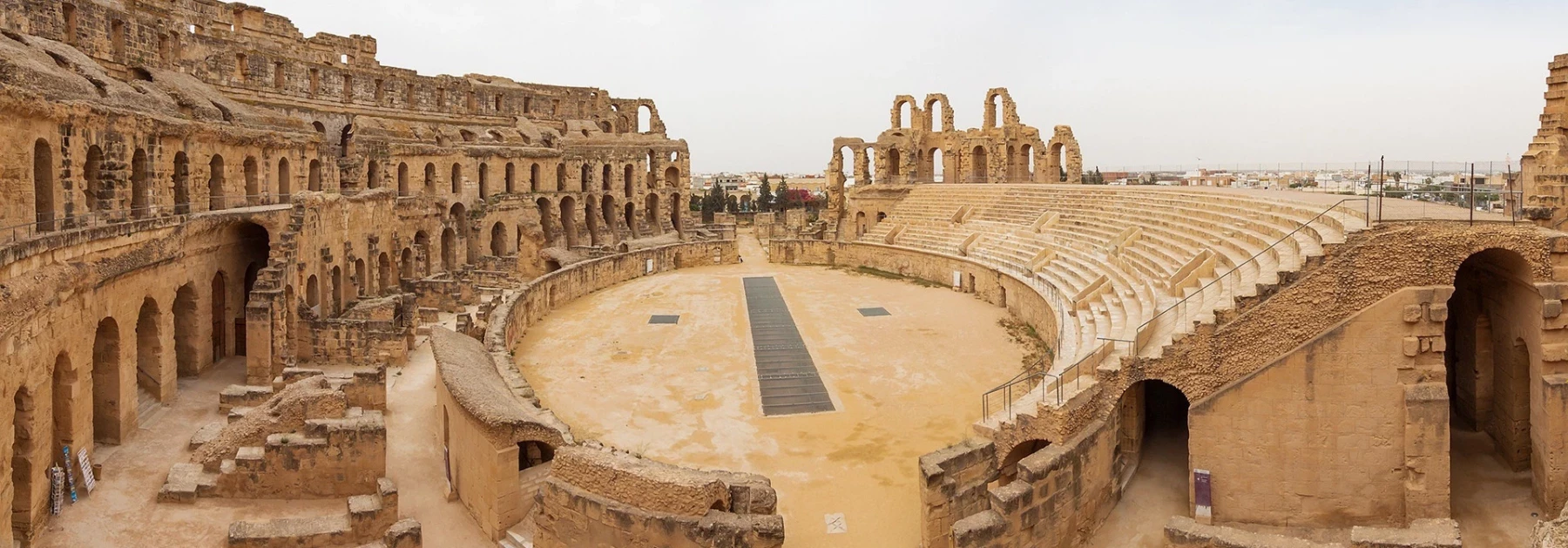The 9 unmissable treasures among the archaeological remains to visit in Tunisia
Last update : 26/05/2024 15:38Summary
Tunisia is a true archaeological treasure, brimming with remnants that trace its rich past. Among the iconic sites is Carthage, an ancient Phoenician and Roman metropolis, boasting majestic temples, imposing baths, and grand amphitheaters. UNESCO-listed Dougga provides an exceptional insight into Roman civilization with its well-preserved theater, temples, and triumphal arches.
Bulla Regia captivates with its underground houses, offering a unique glimpse into daily life during the Roman era. El Djem houses an impressive colosseum, rivalling Rome's, recalling the grandeur of ancient games. Kerkouane, a Punic city, reveals narrow streets and preserved houses, painting an evocative picture of Punic urban planning.
Thuburbo Majus, Haidra, and Sbeitla unveil Roman treasures like forums, temples, and baths, showcasing the prosperity of these ancient cities. Makthar, at the foot of the Aurès Mountains, displays monuments such as the Arch of Caracalla, reminding us of the grandeur of the Roman Empire.
Chott el Jerid, while primarily known for its salt desert, hides petroglyphs and prehistoric remains. Other sites like Utique, Djemila, Monastir, and Chemtou add additional layers to this archaeological tapestry, providing an immersive dive into Tunisia's millennial history. These remnants serve as open windows into the civilizations that shaped this region, creating a rich and captivating narrative for curious visitors.
1 - The archaeological site of Carthage
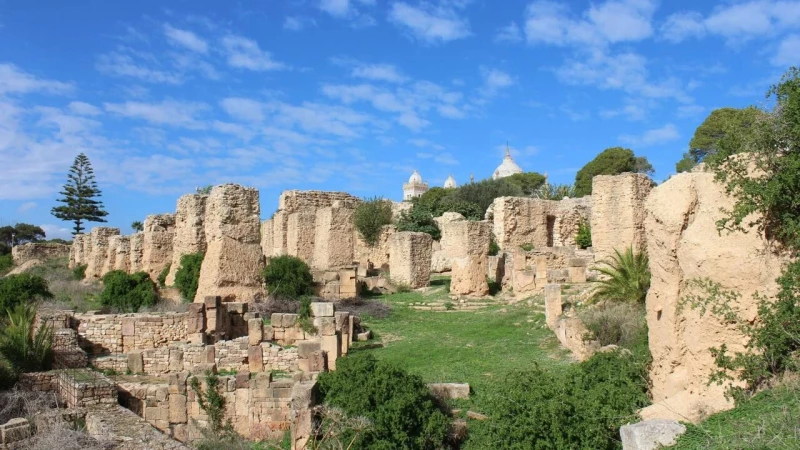
The archaeological site of Carthage, located in Tunisia, stands as one of the most significant ancient cities in Mediterranean history. Founded by the Phoenicians in the 9th century BCE, Carthage evolved into a powerful maritime and commercial force. The present-day remains provide a fascinating glimpse into its rich past.
The ruins encompass residential areas, temples, amphitheaters, baths, and ports, showcasing the diversity of activities that animated the city. Among the most iconic sites are the Punic ports, the Acropolis districts, the Antonine Baths, the Carthage Theater, and the remnants of the tanners' residential quarter.
Carthage's amphitheater, also known as the Colosseum, hosted spectacular events during the Roman era. Preserved mosaics in some residences offer striking artistic and historical details. The temple district, featuring the renowned Tophet sanctuary, reflects the religious aspect of the city.
The site has been designated as a UNESCO World Heritage site due to its historical significance. Ongoing excavations and research continue to unveil new insights into daily life, architecture, and cultural interactions in Carthage. Today, the archaeological site attracts visitors from around the world, providing a captivating immersion into the glorious past of this ancient Mediterranean city.
 Our tips for getting the most out of your experience.
Our tips for getting the most out of your experience.
Visiting the archaeological site of Carthage can be a rewarding experience. Here are some tips to make your visit more enjoyable:
-
Pre-planning: Before your visit, research the opening hours, entrance fees, and any special events that may be taking place.
-
Guides and tours: Hiring a local guide can provide you with in-depth information and a better understanding of Carthage's history. Many agencies offer guided tours.
-
Comfortable footwear: The site is extensive and has uneven paved areas, so comfortable shoes are essential for hassle-free exploration.
-
Sun protection: Depending on the season, it can get hot. Remember to bring sunscreen, a hat, and water to stay hydrated.
-
In-depth exploration: Take the time to explore different parts of the site, including less frequented areas. You might discover quiet corners with exceptional views.
-
Responsible photography: Take photos to capture your visit, but be sure to adhere to the site's photography rules and not disturb other visitors.
-
Local insights: Interact with locals and site staff to get local recommendations, anecdotes, and helpful tips.
-
Off-peak visiting: If possible, plan your visit during off-peak hours to avoid crowds and enjoy a more peaceful experience.
-
Respect site rules: Ensure you follow all site rules, including the preservation of ruins and artifacts. This helps maintain the site in good condition for future generations.
-
Cultural programming: Check for cultural events or temporary exhibitions that may be happening at the site during your visit. This could enhance your experience.
By following these tips, you'll maximize your experience when visiting the archaeological site of Carthage and fully appreciate its history and beauty.
2 - Bulla Regia
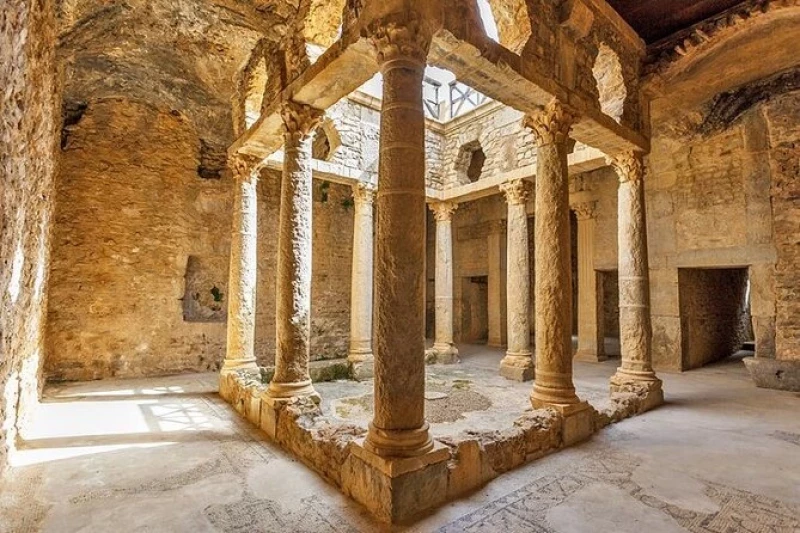
Bulla Regia, situated in present-day Tunisia, stands as a testament to the architectural ingenuity and cultural richness of the ancient Roman world. Flourishing during the 2nd and 3rd centuries AD, this archaeological site is particularly renowned for its distinctive partially subterranean houses. Designed to mitigate the scorching North African heat, these homes boast well-preserved mosaic floors that showcase intricate designs and vibrant colors. The city's historical evolution, initially founded by the Berbers, reflects a harmonious blend of Roman and local influences.
Excavations at Bulla Regia have unveiled a well-planned urban layout, revealing forums, temples, public baths, and a remarkably preserved Roman theater with a seating capacity of around 3,500. The city's adaptability to local climatic conditions is evident in its subterranean architecture, providing cooler living spaces below ground while maintaining functional upper levels. Bulla Regia's civic infrastructure, including its network of streets and water supply systems, attests to the advanced engineering and planning of Roman civilization.
Recognized by UNESCO as part of the archaeological site of Dougga, Bulla Regia has become a popular tourist destination. Visitors can explore the ruins, gaining insights into the daily life of a Roman city and appreciating the fusion of artistic expression from both Roman and local cultures. Despite conservation challenges, the site's educational value remains significant, offering a captivating journey through the history, art, and architecture of this ancient North African city.
 Our tips for getting the most out of your experience.
Our tips for getting the most out of your experience.
Visiting Bulla Regia can be a captivating experience. Here are some tips to enhance your visit:
-
Research in Advance: Before your visit, gather information on opening hours, entrance fees, and the availability of guided tours.
-
Local Guide: Hiring a local guide can enrich your experience by providing detailed insights into the history and unique features of Bulla Regia.
-
Comfortable Footwear: The ruins may have uneven surfaces, so wear comfortable shoes to facilitate exploration.
-
Sun Protection: Given that Bulla Regia is located in a warm region, bring sunscreen, a hat, and water to protect yourself from the sun.
-
Thorough Exploration: Take the time to explore each section of the site, paying particular attention to the well-preserved mosaics.
-
Camera: Don't forget your camera to capture the unique architectural and artistic details of Bulla Regia, but be respectful of the site's photography rules.
-
Understanding Architecture: Familiarize yourself with Roman architecture and the unique design of partially underground houses to better appreciate the remains.
-
Visiting Hours: If possible, plan your visit early in the morning or late in the afternoon to avoid the hottest hours of the day and potentially reduce crowds.
-
Respect Site Rules: Adhere to all rules stated on-site for the preservation of the site and respect for the ruins.
-
Cultural Insights: Take advantage of informational panels and educational materials on-site to deepen your understanding of Bulla Regia and its historical context.
-
Off the Beaten Path: Explore not only the main areas but also less frequented parts of the site for a more intimate experience.
-
Local Interaction: Engage with local staff and residents to gain additional tips and local perspectives.
By following these tips, you'll maximize your experience when visiting Bulla Regia, allowing you to fully appreciate the history and beauty of this unique archaeological site.
3 - Dougga
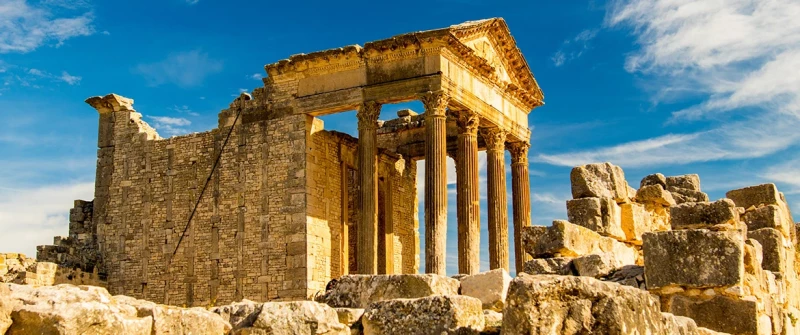
The archaeological site of Dougga, located in Tunisia, is a historical gem that offers a captivating glimpse into Roman and Carthaginian antiquity. Founded in the 6th century BCE by the Berbers, Dougga thrived as a Roman city from the 2nd century BCE to the 5th century CE. The site showcases remarkable architecture, featuring temples, theaters, triumphal arches, baths, and a myriad of public and private structures.
Dougga's theater, with a seating capacity of over 3,500 spectators, attests to the city's cultural significance. The remnants of temples such as the Capitolium and the Temple of Saturn reflect Roman religious influence. Residential quarters reveal exquisite mosaics and architectural elements illustrating the lifestyle of the time.
Designated as a UNESCO World Heritage site, Dougga attracts visitors from around the globe. Its strategic hilltop location also provides panoramic views of the surrounding landscapes. Ongoing conservation efforts aim to preserve this exceptional site, allowing visitors to immerse themselves in the ancient history of the Mediterranean. Exploring Dougga offers a tangible connection to the enduring legacy of different civilizations that have contributed to shaping this unique archaeological site.
 Our tips for getting the most out of your experience.
Our tips for getting the most out of your experience.
Visiting the archaeological site of Dougga can be a rewarding experience. Here are some tips to make the most of your visit:
-
Preparation: Before your visit, gather information about opening hours, entrance fees, and local weather conditions.
-
Local Guide: Hiring a local guide can provide in-depth insights into the history, architecture, and culture of Dougga, enhancing your overall experience.
-
Comfortable Footwear: The ruins may have uneven surfaces, so opt for comfortable shoes for hassle-free exploration.
-
Sun Protection and Hydration: Since Dougga can be exposed to the sun, make sure to bring sunscreen, a hat, and water to stay hydrated.
-
Explore at Your Own Pace: Take the time to explore each section of the site at your own pace. Admire architectural details and discover different parts of the site, from theaters to temples.
-
Responsible Photography: Capture memorable moments, but be sure to follow the site's photography rules to contribute to its preservation.
-
Understand the History: Familiarize yourself with Dougga's history, especially its role as both a Roman and Carthaginian city, to better appreciate what you'll see on-site.
-
Visit During Off-Peak Hours: If possible, plan your visit during off-peak hours to avoid crowds and enjoy a more peaceful experience.
-
Delve into the Details: Explore mosaics, sculptures, and architectural elements with attention. Each detail can tell a fascinating story.
-
Respect Site Rules: Follow all rules outlined on the site to preserve the integrity of the ruins and ensure the safety of visitors.
By following these tips, you can fully enjoy your visit to the archaeological site of Dougga and uncover the richness of its historical heritage.
4 - Kerkouane
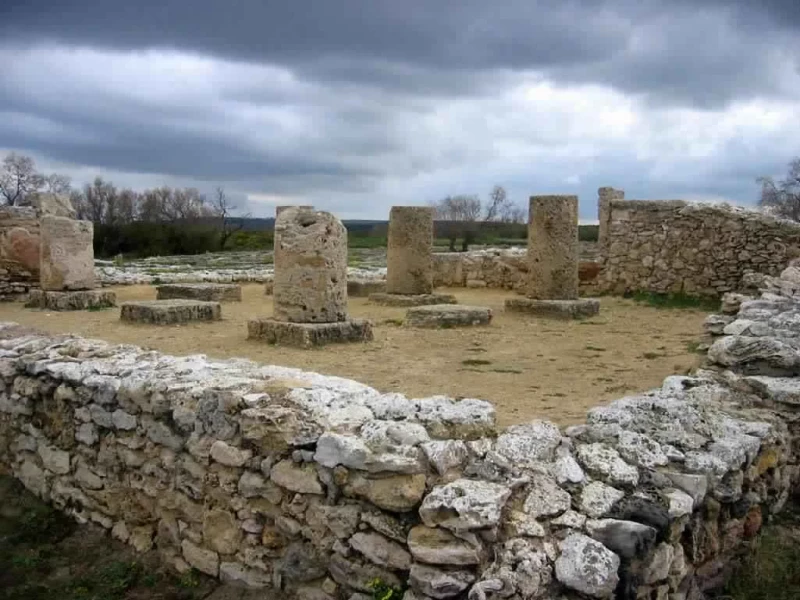
The archaeological site of Kerkouane, nestled on the northeast coast of Tunisia, provides a fascinating glimpse into Punic civilization. Dating back to the 5th century BCE, Kerkouane stands as one of the few preserved Punic cities in its entirety, offering a unique window into daily life during that era. Rediscovered in the 20th century, the site has revealed well-preserved urban planning, including houses, paved streets, and public structures.
What sets Kerkouane apart is its residential architecture, characterized by single-story homes, inner courtyards, and sophisticated hydraulic devices. Excavations have unearthed artifacts, ceramics, and mural frescoes, providing valuable insights into the craftsmanship, religion, and social life of the Punic inhabitants.
Designated as a UNESCO World Heritage site, Kerkouane is a unique portal into the daily life of a flourishing Punic civilization. Its relative isolation from external influences makes it a site of particular importance for archaeologists and history enthusiasts alike, offering visitors an immersive experience into the enigmatic past of the ancient Mediterranean.
 Our tips for getting the most out of your experience.
Our tips for getting the most out of your experience.
Visiting the archaeological site of Kerkouane can be a rewarding experience. Here are some tips to make the most of your visit:
-
Preliminary Information: Before heading out, gather details about opening hours, entrance fees, and local weather conditions.
-
Local Guide: If possible, hire a local guide. A guide can provide in-depth information about the site's history, archaeological discoveries, and Punic culture.
-
Comfortable Footwear: The site may have uneven surfaces, so wear comfortable shoes to facilitate exploration.
-
Sun Protection and Hydration: Kerkouane can be exposed to the sun, so make sure to bring sunscreen, a hat, and water to stay hydrated.
-
Respect Site Rules: Follow all rules outlined on-site to preserve the integrity of the ruins and ensure visitor safety.
-
Responsible Photography: Capture memories, but be sure to adhere to the site's photography rules to contribute to its preservation.
-
Explore Every Detail: Take the time to explore every detail of the site, from architectural structures to displayed artifacts, for a more immersive experience.
-
Understand the History: Familiarize yourself with the history of Kerkouane before your visit to better appreciate the discoveries you'll encounter.
-
Visit During Off-Peak Hours: If possible, plan your visit during off-peak hours to avoid crowds and enjoy a more peaceful experience.
-
Bring a Printed Guide: Carry information about the site or a printed guide for reference during your visit.
By following these tips, you can fully enjoy your visit to the archaeological site of Kerkouane and gain a deeper understanding of this fascinating window into Punic civilization.
5 - El Djem: The Roman amphitheater
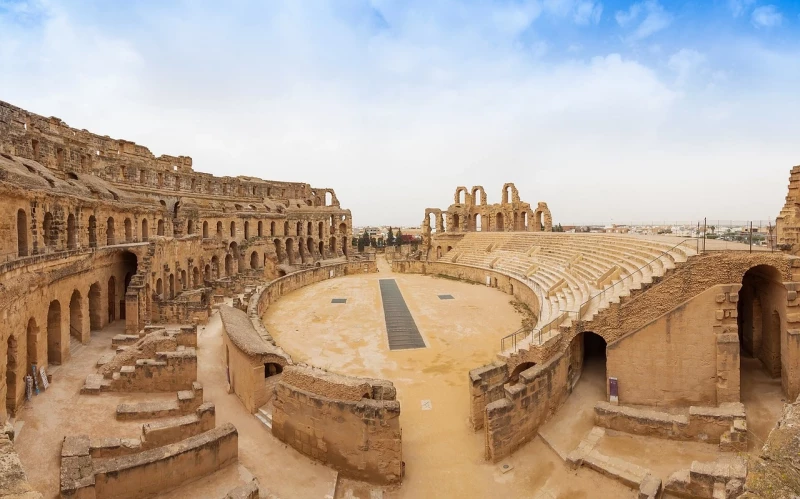
The archaeological site of El Djem, located in Tunisia, is a Roman marvel that showcases the architectural ingenuity of antiquity. At the heart of this site stands the El Djem Amphitheatre, one of the best-preserved in the world, dating back to the 3rd century AD. Modeled after Rome's Colosseum, this colossal structure could accommodate up to 35,000 spectators.
The amphitheater, once dedicated to gladiator contests and public spectacles, is the focal point of the site. Its majestic arches and vast arena evoke the grandeur of events that animated the city of Thysdrus during the Roman era. The remains of stables, lodgings, and underground galleries provide insights into the intricate logistics that underpinned these grand performances.
Designated as a UNESCO World Heritage site, El Djem attracts visitors from around the globe. Beyond the amphitheater, the surrounding ruins include baths, houses, and temples that bear witness to the region's past prosperity. The city of Thysdrus itself, with El Djem at its center, was once a thriving commercial hub.
The grandeur of El Djem's amphitheater and the archaeological wealth that surrounds it make it a must-visit for history enthusiasts and aficionados of ancient architecture. Its imposing silhouette and captivating history offer an impressive immersion into the life of the Roman era in North Africa.
 Our tips for getting the most out of your experience.
Our tips for getting the most out of your experience.
Visiting the archaeological site of El Djem can be a fascinating experience. Here are some tips to make the most of your visit:
-
Preparation: Before heading out, gather information about opening hours, entrance fees, and any available guided tours.
-
Guided Tour: Consider taking a guided tour if possible. Local guides can provide in-depth information about the history of the amphitheater and the region.
-
Skip-the-Line Tickets: If available, consider purchasing skip-the-line tickets to avoid queues, especially during peak times.
-
Comfortable Footwear: The ruins may have uneven surfaces, so wear comfortable shoes to facilitate exploration.
-
Sun Protection and Hydration: Since the site is outdoors, bring sunscreen, a hat, and water to protect yourself from the sun.
-
Camera: Capture photos, but be sure to follow the site's photography rules to contribute to its preservation.
-
Explore Underground: Don't miss the opportunity to descend into the underground galleries of the amphitheater to discover the backstage and infrastructure.
-
Visiting Hours: Plan your visit early in the morning or late in the afternoon to avoid the intense midday heat.
-
Understand the History: Familiarize yourself with the history of the amphitheater and the city of Thysdrus to better appreciate the ruins.
-
Respect Site Rules: Follow all rules outlined on-site to preserve the integrity of the ruins and ensure visitor safety.
By following these tips, you can fully enjoy your visit to El Djem, explore its impressive amphitheater, and delve into the fascinating history of this ancient Roman city.
6 - Utique
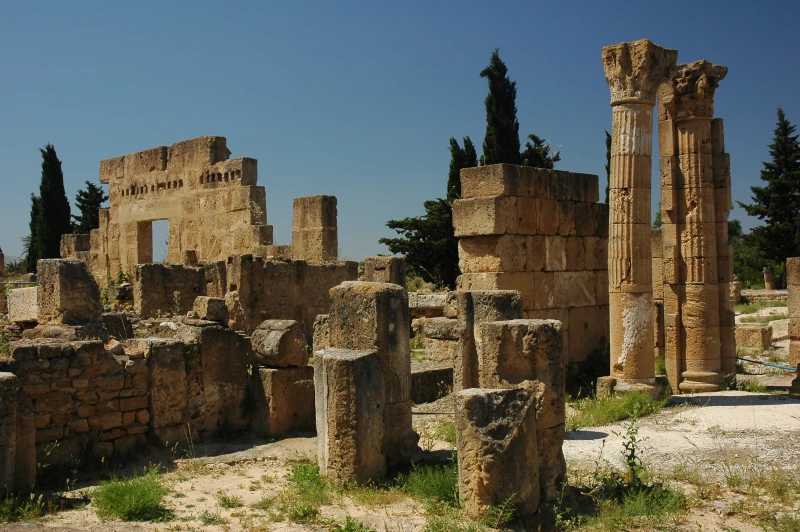
The archaeological site of Utica, situated on the northeast coast of Tunisia, encapsulates a rich history dating back to antiquity. Founded by the Phoenicians in the 9th century BCE, Utica stands as one of the oldest Phoenician colonies in the Mediterranean. The site flourished under Roman rule, evolving into a thriving city with remarkable monuments and public buildings.
One of Utica's highlights is its Roman amphitheater, showcasing the architectural refinement of the era. The remnants of temples dedicated to both Roman and Phoenician deities, along with baths and luxurious residences, reflect the cultural diversity of the city.
Utica also played a pivotal role in the Punic Wars between Rome and Carthage. Its strategic port made it a major stake in crucial battles of ancient history, marking significant chapters in the Mediterranean's complex tapestry of civilizations.
Listed as a UNESCO World Heritage site, Utica attracts visitors with its picturesque ruins, offering an immersive experience into the ancient past. Ongoing excavations continually unveil new findings, contributing to our understanding of this fascinating ancient city and its role in shaping the course of the Western Mediterranean.
 Our tips for getting the most out of your experience.
Our tips for getting the most out of your experience.
Visiting the archaeological site of Utica can be a culturally enriching and historical experience. Here are some tips to enhance your visit:
-
Pre-Research: Familiarize yourself with the history of Utica and key features of the site before your visit to better appreciate the discoveries on-site.
-
Opening Hours: Check the site's opening hours and plan your visit accordingly. Some sites may have specific hours for guided tours.
-
Local Guide: If possible, hire a local guide. A guide can provide detailed information and anecdotes that will enhance your experience.
-
Skip-the-Line Tickets: If available, opt for skip-the-line tickets to avoid queues, especially during peak times.
-
Comfortable Shoes: Wear comfortable shoes as you'll likely be walking on uneven surfaces.
-
Sun Protection and Hydration: Since most archaeological sites are outdoors, bring sunscreen, a hat, and water to protect yourself from the sun.
-
Camera: Capture memories, but make sure to follow the site's photography rules.
-
Respect Site Rules: Follow all rules stated on-site to preserve the integrity of the ruins and ensure visitor safety.
-
Thorough Exploration: Take the time to explore each section of the site, from temples to theaters, to gain a comprehensive view of Utica's historical richness.
-
Visit Timing: Avoid peak hours if possible to enjoy a more peaceful experience and have more time for exploration.
-
Local Interactions: Engage in conversation with local staff for additional tips and insights into the history of the site.
By following these tips, you will maximize your experience when visiting the archaeological site of Utica, allowing you to fully appreciate its historical and cultural significance.
7 - The Archaeological Site of Uthina
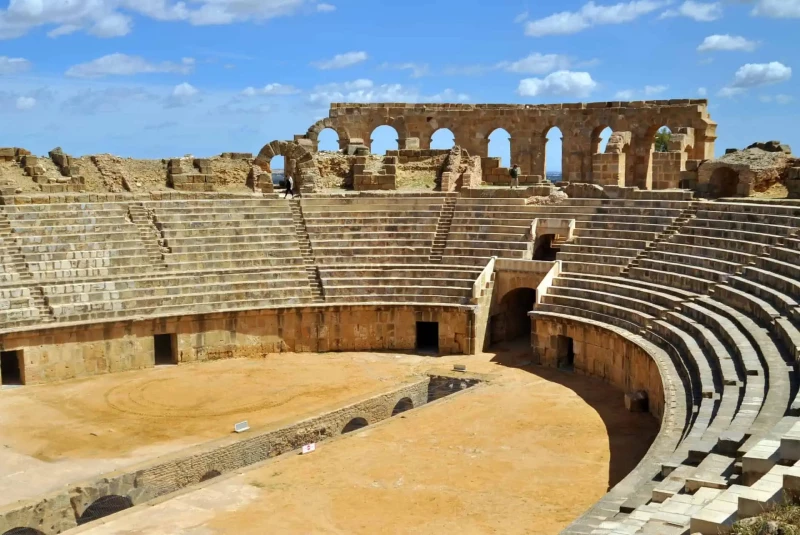
The archaeological site of Uthina, nestled in the region of Tunisia, is a historical treasure that unveils a rich and diverse history. Founded during the Punic era, Uthina flourished under Roman rule, reaching its zenith in the 1st and 2nd centuries CE. The site showcases a variety of remnants, including well-preserved architectural elements like triumphal arches, baths, temples, and private residences.
While Uthina's amphitheater may be more modest compared to some famous Roman structures, it offers an immersive glimpse into the entertainment of the time. Archaeological excavations have also revealed exquisite mosaics, testifying to the artistic refinement of the Roman civilization.
As a less frequented archaeological site compared to some of its neighbors, Uthina provides a more intimate atmosphere for visitors. Exploring this site allows one to step back in time and grasp the daily life of antiquity, all while appreciating the tranquility of its preserved ruins. Recognized as a UNESCO World Heritage site, the archaeological site of Uthina is an underrated gem deserving the attention of history enthusiasts and archaeology aficionados.
 Our tips for getting the most out of your experience.
Our tips for getting the most out of your experience.
Visiting the archaeological site of Uthina can be a captivating experience. Here are some tips to make the most of your visit:
-
Pre-research: Familiarize yourself with the history of Uthina and its main archaeological sites before your visit to better appreciate each discovery.
-
Local guide: If possible, hire a local guide. Guides can provide in-depth information and fascinating anecdotes about the site.
-
Comfortable footwear: Since you'll be exploring ruins, wear comfortable shoes to facilitate walking on sometimes uneven surfaces.
-
Sun protection and hydration: Make sure to bring sunscreen, a hat, and water, especially if you're visiting during the hot hours of the day.
-
Responsible photography: Capture memories, but adhere to the site's photography rules to contribute to its preservation.
-
Visiting hours: Plan your visit early in the morning or late in the afternoon to avoid intense heat and enjoy a more peaceful atmosphere.
-
Thorough exploration: Take the time to explore every corner of the site, especially mosaics and architectural structures, for a more comprehensive experience.
-
Entrance tickets: Make sure to know the entrance fees and available options, such as skip-the-line tickets if offered.
-
Respect site rules: Follow all rules stated on-site to preserve the integrity of the ruins and ensure visitor safety.
-
Local interactions: Engage in conversation with locals to get additional tips and local insights about the site.
By following these tips, you'll have an immersive and enriching experience exploring the archaeological site of Uthina.
8 - The archaeological site of Sbeïtla: Sufetula
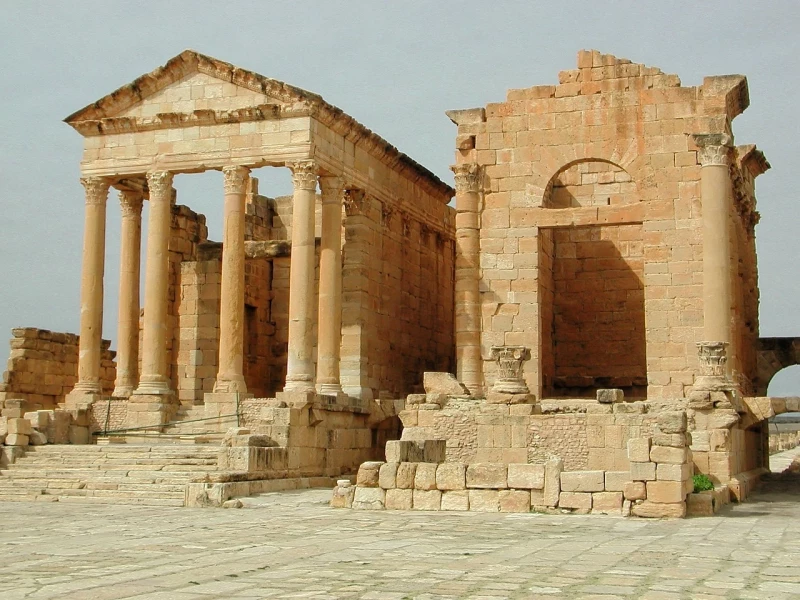
The archaeological site of Sbeïtla, formerly known as Sufetula, stands as a historical gem located in Tunisia, providing an impressive glimpse into Roman antiquity. Founded in the 2nd century BCE, Sufetula thrived as a Roman city, bearing witness to its strategic significance and economic prosperity. The site is dominated by its imposing triumphal arch erected for Emperor Antoninus Pius in the 2nd century.
Sufetula's amphitheater, with a capacity of approximately 3,500 spectators, remains well-preserved, offering an immersive insight into Roman entertainment. The baths, temples, and remnants of private homes adorned with mosaics illustrate the flourishing daily life of the city during the Roman era.
The Sbeïtla Museum complements the experience by showcasing archaeological discoveries, including statues, pottery, and everyday objects. The site, designated as a UNESCO World Heritage site, attracts visitors with its unique blend of Roman ruins and Tunisian history, making Sbeïtla a must-visit for enthusiasts of archaeology and ancient history.
 Our tips for getting the most out of your experience.
Our tips for getting the most out of your experience.
Visiting the archaeological site of Sbeïtla can be an exciting experience. Here are some tips to make the most of your visit:
-
Pre-research: Familiarize yourself with the history of Sbeïtla and its main points of interest before visiting the site to better appreciate each discovery.
-
Local guide: Hire a local guide for a more enriching tour. Guides can provide detailed information about the history and share anecdotes related to the site.
-
Visiting hours: Plan your visit early in the morning or late in the afternoon to avoid the intense midday heat and enjoy a more peaceful atmosphere.
-
Comfortable footwear: Since you'll be exploring ruins, wear comfortable shoes to facilitate walking on sometimes uneven surfaces.
-
Sun protection and hydration: Bring sunscreen, a hat, and water to protect yourself from the sun, especially if you're visiting during the warmer months.
-
Camera: Capture memories, but be mindful of the site's photography rules to preserve its integrity.
-
Sbeïtla Museum: Don't miss visiting the Sbeïtla Museum to discover additional archaeological artifacts and gain a better understanding of the site's history.
-
Respect site rules: Follow all rules and guidelines on-site to preserve the ruins and ensure a pleasant experience for all visitors.
-
Thorough exploration: Take the time to explore each section of the site, especially architectural details and mosaics, for a more comprehensive experience.
-
Local interactions: Engage with local residents to get additional tips and discover lesser-known aspects of the site.
By following these tips, you'll be better prepared for an enriching visit to the archaeological site of Sbeïtla and can fully appreciate its fascinating history.
9 - The archaeological site of Gigthis
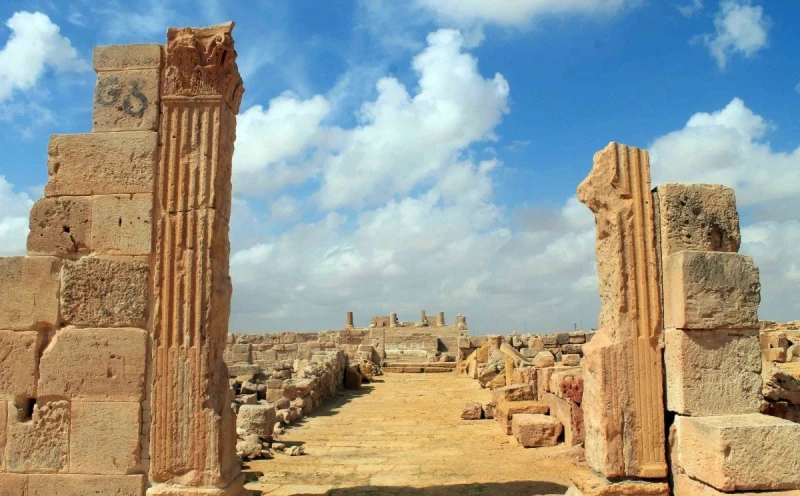
The archaeological site of Gigthis, located in Tunisia, is a true window into the ancient history of the region. Founded during the Punic era, this ancient city experienced a prosperous period under Roman rule. The remaining ruins today bear witness to its historical significance and rich heritage.
At the heart of the site is a Roman amphitheater, symbolizing the cultural and architectural influence of the Roman Empire in the region. The arches, seating, and related structures reveal the ingenuity of Roman construction.
Archaeological excavations have also uncovered baths, temples, and residences, providing insights into daily life in this once-thriving city. Mosaics, sculptures, and other artifacts attest to the artistic sophistication of the Roman civilization that left its mark on Gigthis.
While less frequented than some neighboring sites, the archaeological site of Gigthis offers visitors an authentic and immersive experience into the ancient history of Tunisia. Its relative tranquility allows for a full appreciation of the preserved ruins and a deep dive into the fascinating past of this ancient city.
 Our tips for getting the most out of your experience.
Our tips for getting the most out of your experience.
Visiting the archaeological site of Gigthis can be an enriching experience. Here are some tips to make the most of your visit:
-
Pre-research: Learn about the history of Gigthis and the main archaeological discoveries before your visit to better understand the context.
-
Local guide: Hire a local guide if possible. Guides can provide in-depth information and anecdotes that add an extra dimension to your experience.
-
Visiting hours: Plan your visit during the cooler hours of the day, early in the morning or late in the afternoon, to avoid the intense heat.
-
Comfortable footwear: Since you'll be exploring ruins, wear comfortable shoes to facilitate walking on uneven surfaces.
-
Sun protection and hydration: Bring sunscreen, a hat, and water to protect yourself from the sun, especially if you're visiting during the warmer months.
-
Camera: Capture memorable pictures, but make sure to respect the site's photography rules.
-
Explore less crowded areas: Take the time to explore less frequented corners of the site for a more personal experience.
-
Respect site rules: Follow the site rules to preserve the integrity of the ruins and ensure visitor safety.
-
Local museum: If a local museum is available, consider visiting it to deepen your understanding of the archaeological discoveries of Gigthis.
-
Interact with locals: Engage with local residents to gain additional insights and tips for visiting the site.
By following these tips, you'll be able to fully enjoy your visit to the archaeological site of Gigthis and immerse yourself in its rich history.
Archaeological remains present in Tunisia - Where to Stay?
To visit the archaeological sites in Tunisia, it is recommended to choose strategic accommodation that provides easy access to these sites while offering quality services. Here are some popular places to stay in Tunisia, based on proximity to archaeological sites:
-
Tunis: The capital offers convenient access to sites such as Carthage and the Medina of Tunis. You will find a variety of accommodation, from luxury hotels to traditional guesthouses.
-
Sidi Bou Said: This charming coastal town near Tunis is known for its cobblestone streets, white and blue houses, and is close to Carthage.
-
Hammamet: A popular seaside resort, Hammamet is close to sites like Bulla Regia. There are many resorts offering all-inclusive services.
-
Sousse: This port city is well located to explore sites like Dougga and El Djem. It offers a range of accommodation options, from luxury hotels to hostels.
-
Kairouan: If you want to explore central Tunisia, Kairouan is an ideal base for sites like Sbeitla. The city offers historic hotels and guesthouses.
-
Nabeul: Located near the coast, this city is close to Kerkouane and offers various types of accommodation, from family-friendly hotels to luxury establishments.
When choosing your accommodation, consider your preferences, budget, and the proximity of the archaeological sites you plan to visit.
Archaeological remains present in Tunisia - How to get around?
Getting around to visit archaeological sites in Tunisia can be done through various means, depending on your preferences, budget, and the specific location of the sites you want to explore. Here are some transportation options to consider:
-
Car Rental: Renting a car provides maximum flexibility, allowing you to plan your itinerary and visit more remote sites. Major car rental agencies are available at airports and major cities.
-
Private Driver: If you prefer not to drive yourself, you can hire a private driver. This can be a comfortable option, especially if you want the local insights of a guide.
-
Taxis: Taxis are available in most Tunisian cities. Make sure to agree on the fare before departing, or ask the driver to use the meter. For longer excursions, consider negotiating a fixed rate.
-
Public Transportation: Buses and trains are affordable options for traveling between cities. However, direct access to archaeological sites may sometimes require additional taxi rides or walking.
-
Guided Tours: Participating in organized guided tours can simplify transportation. Agencies often offer tours that include transportation, guides, and sometimes even meals.
-
Bicycles or Scooters: In some regions, you can rent bicycles or scooters for easier local transportation, especially if the sites are close to each other.
-
On Foot: Some archaeological sites are located close to each other, allowing you to explore them on foot, especially in historic medinas and city centers.
When planning your itinerary, check the availability of transportation in the region you want to visit and choose the method that best fits your needs and preferences.
Archaeological remains present in Tunisia - Best period
The best time to visit archaeological sites in Tunisia is generally during the spring (March to May) and fall (September to November). During these seasons, the weather is typically pleasant, with moderate temperatures, making the exploration of sites more comfortable.
Spring (March to May):
- Mild temperatures, avoiding the excessive heat of summer.
- Lush vegetation adds to the aesthetics of the sites.
- Tourist crowds are generally less compared to the summer months.
Fall (September to November):
- Temperatures start to cool down after the hot summer months.
- The Mediterranean Sea remains relatively warm, allowing for beach enjoyment as well.
- Weather conditions are favorable for exploration.
Avoid the summer months (June to August) if possible, as temperatures can soar, sometimes exceeding 40 degrees Celsius (104 degrees Fahrenheit). Archaeological sites can become uncomfortable to visit during the hottest parts of the day.
It's also essential to consider holiday periods, as some regions may experience higher tourist traffic during school breaks and national holidays. Before planning your visit, check the specific weather forecasts for the region you intend to explore and verify the opening hours of individual sites
